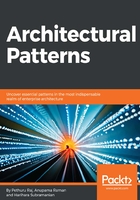
Layered/tiered architecture
This pattern is an improvement over the client/server architecture pattern. This is the most commonly used architectural pattern. Typically, an enterprise software application comprises three or more layers: presentation / user interface layer, business logic layer, and data persistence layer. Additional layers for enabling integration with third-party applications/services can be readily inscribed in this layered architecture. There are primarily database management systems at the backend, the middle tier involves an application and web server, and the presentation layer is primarily user interface applications (thick clients) or web browsers (thin clients). With the fast proliferation of mobile devices, mobile browsers are also being attached to the presentation layer. Such tiered segregation comes in handy in managing and maintaining each layer accordingly. The power of plug-in and play gets realized with this approach. Additional layers can be fit in as needed. There are model view controller (MVC) pattern-compliant frameworks hugely simplifying enterprise-grade and web-scale applications. MVC is a web application architecture pattern. The main advantage of the layered architecture is the separation of concerns. That is, each layer can focus solely on its role and responsibility. The layered and tiered pattern makes the application:
- Maintainable
- Testable
- Easy to assign specific and separate roles
- Easy to update and enhance layers separately
This architecture pattern is good for developing web-scale, production-grade, and cloud-hosted applications quickly and in a risk-free fashion. The current and legacy-tiered applications can be easily modified at each layer with newer technologies and tools. This pattern remarkably moderates and minimizes the development, operational, and management complexities of software applications. The partitioning of different components participating in the system can be replaced and substituted by other right components. When there are business and technology changes, this layered architecture comes in handy in embedding newer things in order to meet varying business requirements.
As illustrated in the following figure, there can be multiple layers fulfilling various needs. Some layers can be termed as open in order to be bypassed during some specific requests. In the figure, the services layer is marked as open. That is, requests are allowed to bypass this opened layer and go directly to the layer under it. The business layer is now allowed to go directly to the persistence layer. Thus, the layered approach is highly open and flexible.

In short, the layered or tiered approach is bound to moderate the rising complexity of software applications. Also, bypassing certain layers, the flexibility is being incorporated easily. Additional layers can be embedded as needed in order to bring highly synchronized applications.